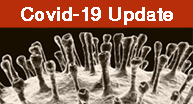The successful management of Thirty-six hepatopancreatobiliary surgeries under the intensive protective arrangements during the COVID-19 pandemic
Keywords:
Keywords: liver transplant, hepatopancreatobiliary surgery, COVID-19.Abstract
ackground: During the pandemic of COVID-19, the overwhelm of infected patients created an exponential surge for ICU and ward beds. As a result, a major proportion of elective surgeries was postponed. However, various emergency and urgent procedures were allowed. Due to the mortality complications of hepatopancreatobiliary issues, we decided to afford urgent procedures under intensive protective arrangements. Method and results: In our ward (liver transplant), 4 ICU beds and 16 ward beds were allocated to non-COVID-19 patients. A total of 36 hepatopancreatobiliary procedures were managed for one month. All the surgeries were afforded under personal protective equipment and other intensive protective arrangements for personnel and patients. During 6 weeks following the surgery, all patients were followed up through telemedicine and no new case of COVID-19 was detected. Conclusion: In general, it appears that intensive protections could significantly reduce the number of COVID-19 incidence among patients with co-morbidities who undergo invasive procedures.
References
Wang C, Horby PW, Hayden FG, Gao GF. A novel coronavirus outbreak of global health concern. Lancet (London, England). Feb 15 2020;395(10223):470-473. doi:10.1016/s0140-6736(20)30185-9
(WHO) WHO. Coronavirus disease 2019 (COVID-19) Situation Report 110th Accessed April, 20, 2020. https://www.who.int/docs/default-source/coronaviruse/situation-reports/20200420-sitrep-91-covid-19.pdf?sfvrsn=fcf0670b_4
Stahel PF. How to risk-stratify elective surgery during the COVID-19 pandemic? Patient safety in surgery. 2020;14:8. doi:10.1186/s13037-020-00235-9
Woolley AE, Mehra MR. Dilemma of organ donation in transplantation and the COVID-19 pandemic. The Journal of Heart and Lung Transplantation. 2020;
Ren Z-L, Hu R, Wang Z-W, et al. Epidemiological and clinical characteristics of heart transplant recipients during the 2019 coronavirus outbreak in Wuhan, China: a descriptive survey report. The Journal of Heart and Lung Transplantation. 2020;
Barros L, Rivetti LA, Furlanetto BH, Teixeira EM, Welikow A. COVID-19: General guidelines for cardiovascular surgeons (standard guidelines-subject to change). Brazilian Journal of Cardiovascular Surgery. 2020;35(2):I-III.
Correia M, Ramos RF, Bahten LCV. The surgeons and the COVID-19 pandemic. Revista do Colégio Brasileiro de Cirurgiões. 2020;47
Xin L, Minghui L, Qingchun Z, et al. Preliminary recommendations for lung surgery during 2019 novel coronavirus disease (COVID-19) epidemic period. Zhongguo Fei Ai Za Zhi. 2020;23(3)
Matthay MA, Zemans RL, Zimmerman GA, et al. Acute respiratory distress syndrome. Nature reviews Disease primers. Mar 14 2019;5(1):18. doi:10.1038/s41572-019-0069-0
Vishnevetsky A, Levy M. Rethinking high-risk groups in COVID-19. Multiple sclerosis and related disorders. Apr 22 2020;42:102139. doi:10.1016/j.msard.2020.102139
Bourgonje AR, Abdulle AE, Timens W, et al. Angiotensin-converting enzyme-2 (ACE2), SARS-CoV-2 and pathophysiology of coronavirus disease 2019 (COVID-19). The Journal of pathology. May 17 2020;doi:10.1002/path.5471
Xu L, Liu J, Lu M, Yang D, Zheng X. Liver injury during highly pathogenic human coronavirus infections. Liver international : official journal of the International Association for the Study of the Liver. May 2020;40(5):998-1004. doi:10.1111/liv.14435
Varga Z, Flammer AJ, Steiger P, et al. Endothelial cell infection and endotheliitis in COVID-19. The Lancet. 2020;395(10234):1417-1418.
Coccolini F, Perrone G, Chiarugi M, et al. Surgery in COVID-19 patients: operational directives. World Journal of Emergency Surgery. 2020;15:1-7.
De Simone B, Chouillard E, Di Saverio S, et al. Emergency surgery during the COVID-19 pandemic: what you need to know for practice. The Annals of The Royal College of Surgeons of England. 2020;(0):1-10.
Li Y, Qin J, Wang Z, et al. Surgical treatment for esophageal cancer during the outbreak of COVID-19. Zhonghua zhong liu za zhi [Chinese journal of oncology]. 2020;42:E003-E003.
Fishman JA, Grossi PA. Novel Coronavirus‐19 (COVID‐19) in the immunocompromised transplant recipient:# Flatteningthecurve. American Journal of Transplantation. 2020;
Han Y, Jiang M, Xia D, et al. COVID-19 in a patient with long-term use of glucocorticoids: A study of a familial cluster. Clinical Immunology. 2020:108413.
Tschopp J, L’Huillier A, Mombelli M, et al. First experience of SARS‐CoV‐2 infections in solid organ transplant recipients in the Swiss Transplant Cohort Study. American Journal of Transplantation. 2020;

Downloads
Published
Issue
Section
License
This is an Open Access article distributed under the terms of the Creative Commons Attribution License (https://creativecommons.org/licenses/by-nc/4.0) which permits unrestricted use, distribution, and reproduction in any medium, provided the original work is properly cited.
Transfer of Copyright and Permission to Reproduce Parts of Published Papers.
Authors retain the copyright for their published work. No formal permission will be required to reproduce parts (tables or illustrations) of published papers, provided the source is quoted appropriately and reproduction has no commercial intent. Reproductions with commercial intent will require written permission and payment of royalties.






